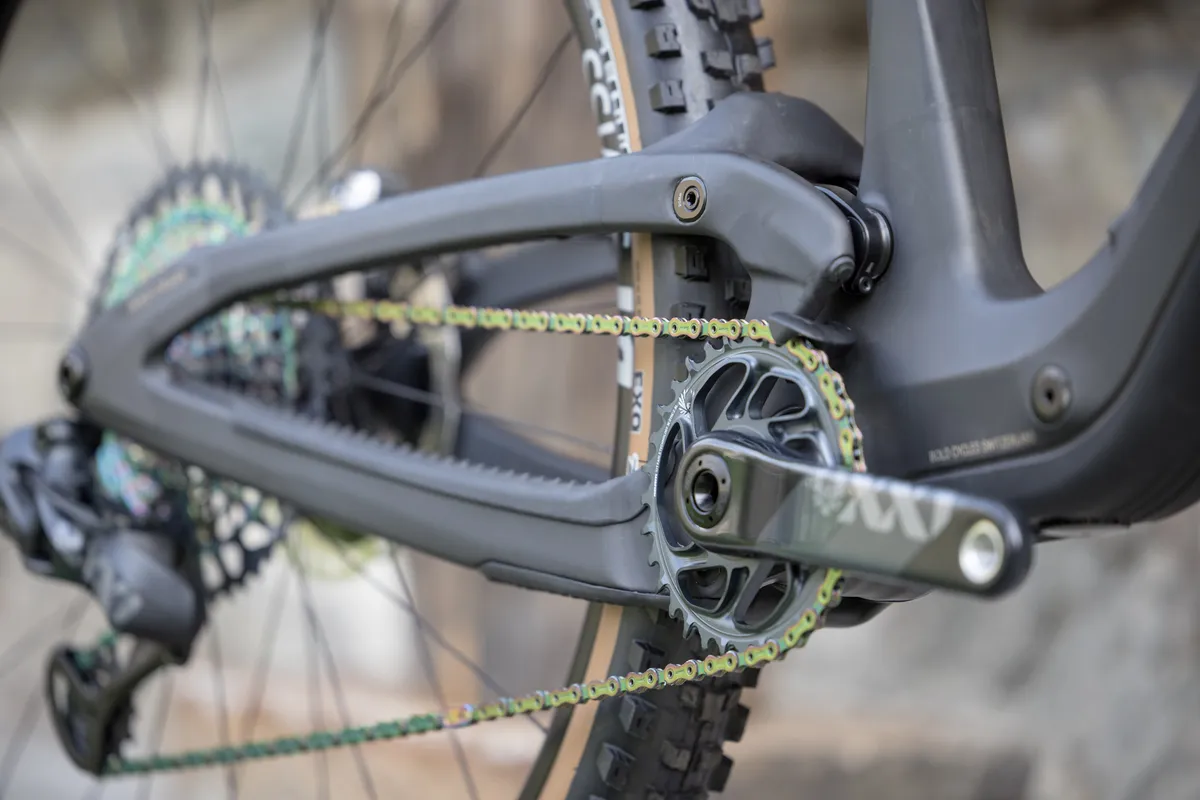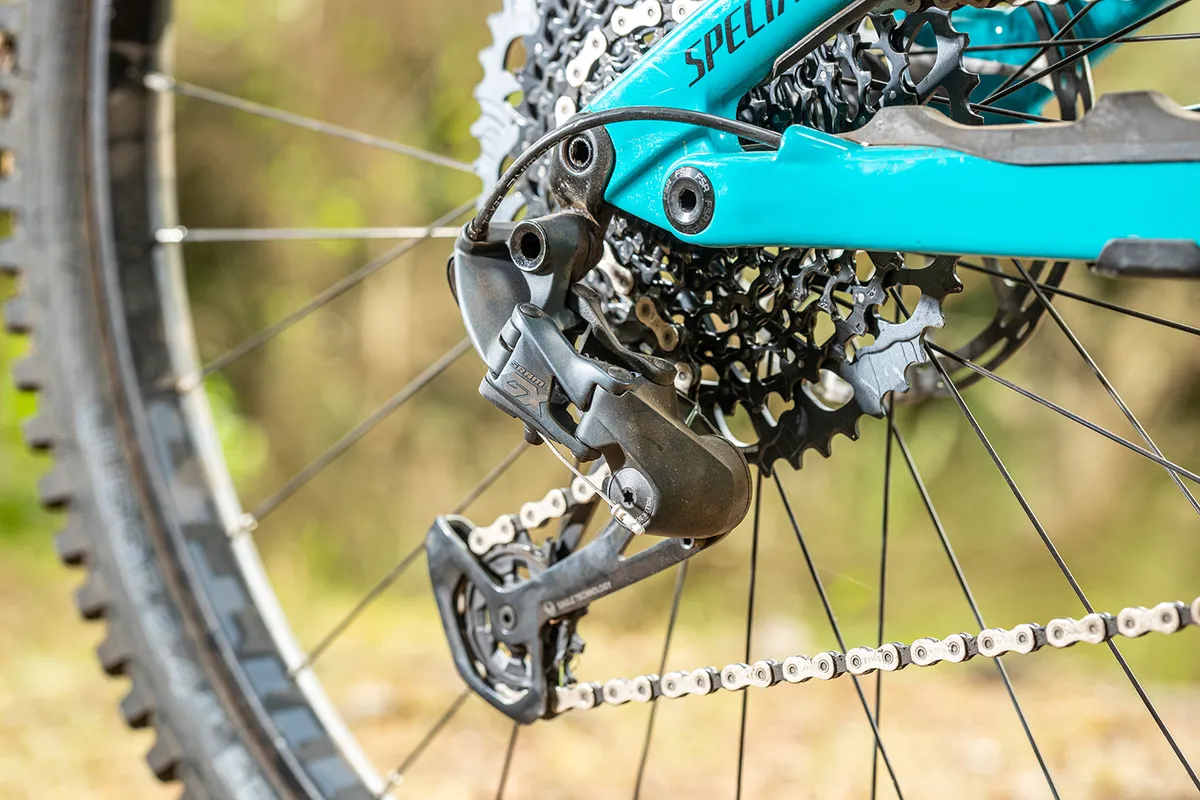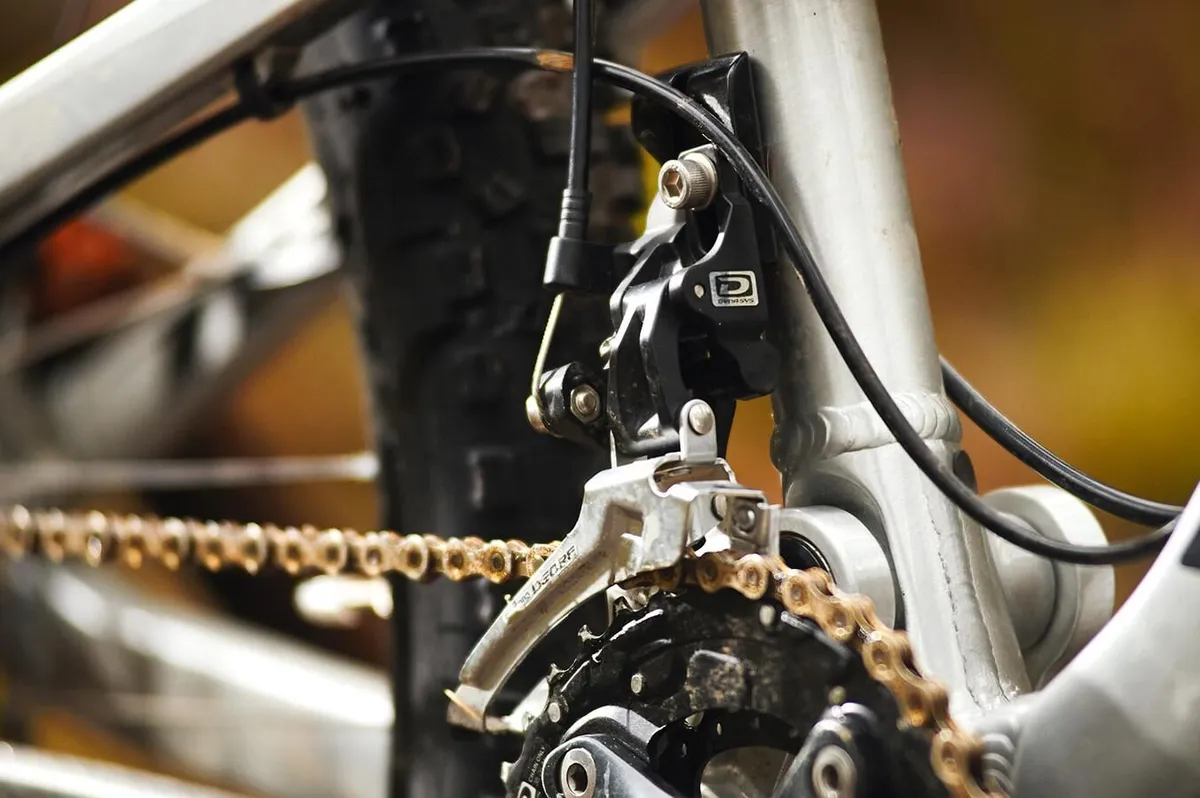While many bikes feature two or three chainrings and a front derailleur, an increasing number of bikes now use a 1x (pronounced ‘one-by’) drivetrain, with only a single chainring and no front derailleur.
This is not new technology. Many riders converted to the 1x system in the past, with the use of chain catchers or after-market component solutions. But the number of mass-produced, dedicated 1x drivetrains available to consumers has grown in recent years, in line with the setup's popularity.
SRAM was the first major manufacturer to develop a dedicated 1x drivetrain in 2012 with its XX1 mountain bike groupset and, over time, other brands have introduced their own solutions.
In this guide, we’ll explore what exactly constitutes a 1x drivetrain and take a brief look at their usage on various genres of bikes, before heading into their advantages and disadvantages.
- What is a 1x drivetrain?
- 1x mountain bikes
- 1x gravel bikes
- 1x road bikes
- Which other bikes use a 1x drivetrain?
- What are the advantages of 1x?
- What are the disadvantages of 1x?
- 1x drivetrain vs 2x drivetrain
- Can I convert my bike to a 1x drivetrain?
What is a 1x drivetrain?

In simple terms, a 1x drivetrain has a single chainring mounted to the crankset, with no front derailleur.
Bike cranksets have historically had two or three chainrings, with a derailleur to move the chain between chainrings. By extension, if a bike had two chainrings, it would be referred to as a 2x drivetrain, and three chainrings would be referred to as a 3x. These are also commonly referred to as a 'double' or 'triple' setup respectively.
Having two or three chainrings gives you a wide range of gears with smaller jumps between each gear. This can enable you to fine-tune your gear so you're not pedalling too easy or too hard.
A smaller inner chainring on a 2x setup also enables you change into an easier gear to tackle climbs (or vice versa) more quickly than you would be able to on a 1x setup.
Because 1x drivetrains only have one chainring, they eliminate the need for a front derailleur. The front derailleur shifter is also eliminated, as is the gear cable that would typically run between the shifter and front derailleur.

Most bikes with 1x drivetrains feature a wider-range cassette, which tends to have harder smallest cogs and an easier largest cog. This ensures you have an adequate range for climbing and descending, without the need for additional chainrings to add gearing range.
Many 1x drivetrains are further refined in terms of chain retention, to stop the chain from falling off the single chainring or from slapping on the driveside chainstay whenever you ride over choppy terrain.
1x-specific rear derailleurs often feature a clutch mechanism to better hold the chain, preventing noise and quietening the ride.
The chainrings typically used on 1x drivetrains feature a narrow-wide profile, which means the alternating teeth are narrow and wider. This meshes with the chain, allowing it to be better retained on the chainring and stopping it from falling off the chainring and getting caught between the frame and crankset.
1x drivetrains on mountain, gravel and road bikes
1x drivetrains are used across cycling disciplines for different reasons and with varying popularity.
1x mountain bikes

Although 1x drivetrains have featured on the best mountain bikes for many years, the technology really came to the fore when SRAM announced its 1x11 XX1 groupset in October 2012.
The brand has continued to develop and embrace 1x drivetrain mountain bike gearing. It was the first to bring 12-speed drivetrains to mountain biking with its Eagle drivetrain ecosystem in March 2016.
Many mountain bikes are now designed to run 1x only, thanks to the simplicity of a single-chainring setup.
By omitting the front derailleur, manufacturers can get more creative with their frame designs. This is especially true of rear-suspension designs.
With no need to accommodate a front derailleur, there are more options for pivot-point placement.
Pivot points can also be made wider, improving stiffness and longevity. With a narrower range of chainring options, fewer compromises need to be made when considering suspension kinematics, improving features such as the compliance of the frame or rear-suspension design.
SRAM no longer manufactures any 2x mountain bike groupsets, although Shimano still offers front derailleurs throughout its range.
However, some budget mountain bikes may still make use of 2x and 3x drivetrains.
1x gravel bikes

Many of the best gravel bikes now use 1x drivetrains, although there are still some that use 2x systems.
SRAM’s cyclocross-oriented Force CX1 1x drivetrain was specced on many early dedicated gravel bikes. The brand offers 1x systems with its mechanical ‘1’ range and its XPLR eTap AXS electronic groupsets. However, it also still manufactures 2x drivetrains for gravel bikes.
Shimano released dedicated 1x components for gravel bikes in 2019 with the launch of Shimano GRX.
Campagnolo introduced its gravel Ekar groupset in 2020, which is 1x only and features 13-speeds.
Some gravel bikes are now designed to run 1x only, while others can be run with 1x or 2x drivetrains.
When it comes to gravel bike setup, choosing between 1x and 2x often depends on riding style and the type of terrain typically encountered.
If your gravel riding sees you out on the road more and you’d prefer to have a greater selection of gears to ride at an optimum cadence, then 2x is the way to go.
However, if your riding sees you heading out on more technical gravel terrain and you’d prefer the benefits of the simplicity and improved chain retention, then a 1x drivetrain may be a better choice.
1x road bikes

Using 1x drivetrains on road bikes has yet to really take off and the majority of bikes still run 2x drivetrains.
2x drivetrains provide tighter gear ratios than 1x drivetrains. This is preferable for road cycling because the change in gradients is more gradual than in an off-road setting, which typically varies between extremes in terms of terrain.
Notoriously, the pro team Aqua Blue used the 3T Strada with a 1x drivetrain to mixed effect and frustration from the team’s riders. More recently, a number of professional road cyclists have taken to using 1x drivetrains on flat stages and races with cobbles, such as Lizzie Deigan at the 2021 edition of Paris-Roubaix.

1x is sometimes used for time trials and triathlons, typically on flatter stages where the inner chainring isn’t needed. Some brands even manufacture aerodynamically optimised time-trial 1x chainrings for this purpose.
Which other bikes use a 1x drivetrain?

Some of the best cyclocross bikes use 1x drivetrains because they can be particularly useful on especially muddy courses, which can clog up the front derailleur on a 2x setup.
Some of the best hybrid bikes also use 1x drivetrains, primarily due to their more simplistic operation and the fact many commuters won’t be riding over demanding terrain.
Many of the best electric bikes use 1x drivetrains, too, especially when their motors are bottom-bracket based and non-compatible with a front derailleur.
What are the advantages of a 1x drivetrain?
1x drivetrains have a number of advantages, including simplicity, weight-saving and easier maintenance.
Simplicity

A 1x drivetrain is simpler to operate than a drivetrain with multiple chainrings because you don’t have to worry about shifting a front derailleur. Instead, you only need to shift the gears up and down the cassette.
On a mountain bike, there is one shifter to worry about and the redundant shifter can be removed from the handlebars.
A 1x drivetrain also eliminates duplicate gears. There are generally a number of duplicate gears on 2x and 3x setups, which have the same gear ratio. For example, on a 2x setup using 50/34 chainrings and an 11-28 cassette, there are three sets of duplicate gears.
In addition, you lose the use of another two to three gears, which would otherwise result in cross-chaining.
You also reduce the number of parts used and, by extension, parts to replace in the future.
Weight-saving

1x drivetrains are generally lighter than 2x or 3x drivetrains because they forgo chainrings, front derailleurs and corresponding cables.
However, if you're using a clutch-equipped rear derailleur, this component will almost always see an increase in weight over non-clutched rear derailleurs.
If you change to a wider-ranging cassette, this will also increase the weight compared to a tighter cassette on a 2x setup.
Maintenance

1x drivetrains are easy to maintain, largely due to the fact there is only one derailleur to adjust and keep in working order.
You don’t need to worry about installing or maintaining a front derailleur, and you don’t need to focus on trimming it in certain gear combinations when riding if the chain rubs on the inner cage plate.
Cleaning is straightforward, too. The front derailleur is often a mud magnet and it’s much easier to clean a single front chainring than getting mud and grime out of the crevices between multiple chainrings.
Better chain retention

When using a clutch-equipped rear derailleur and narrow-wide chainring, a 1x drivetrain is quieter-running than a 2x or 3x system.
On top of that, the clutch stops the chain from slapping on the driveside chainstay and the narrow-wide chainrings better secure the chain.
Frame design can evolve

2x and 3x drivetrains place restrictions on what frame designers can do because they have to include mounting points for the front derailleur and accommodate cranksets with multiple chainrings.
1x drivetrains, on the other hand, mean designers can start to play around with the design of the seat tube.
Freed from accommodating derailleur mounts and chainrings, manufacturers can adjust seat tube design to increase tyre clearance, frame stiffness or compliance.
1x allows for shorter chainstay lengths because the chainline won’t interfere with the rear tyre. A shorter chainstay length creates a more nimble and lively riding quality and, on some bikes, lifts the front wheel over obstacles.
For mountain bikes, the lack of front derailleur mounts allows for more complex suspension designs and kinematics. The suspension pivots can be moved further down the seat tube, improving the suppleness of the suspension.
Cost

Because they have fewer components, 1x drivetrains tend to cost less than equivalent 2x drivetrains.
For example, a Shimano GRX 810 1x groupset has a recommended retail price of £999 and the equivalent GRX 810 2x groupset is £1,049.
A SRAM Red eTap AXS 2x groupset retails for £2,423 and opting for a 1x setup would decrease the price to £1,978.
What are the disadvantages of a 1x drivetrain?
There are some disadvantages to the system, such as the larger jumps between gears, the possibility of increased wear on certain components and complications around freehub standards.
Gearing span and larger jumps between gears

Often, 1x drivetrains have half the number of gears of 2x drivetrains, yet they still need to achieve the same – or nearly the same – gear range to help riders get over climbs and travel at speed.
To get around this issue, most 1x drivetrains have massive rear cassettes. For example, SRAM Eagle boasts a 10-52 tooth cassette and Shimano’s mountain bike groupsets have 10-51 cassettes.
As a result, these SRAM and Shimano 1x mountain bike drivetrains have a gear range of more than 500 per cent, but this still isn’t as large a range as some 2x drivetrains.
This means choosing the correct chainring size and cassette ratio to achieve the gear range you need for where you ride is key.
However, even if the gear range is sufficient, you may find the jumps between gears are large, disrupting cadence and your pedal stroke.
This isn’t so much of an issue riding off-road, but if you are riding on the road or with a group of people, the inability to select a gear that allows you to retain the same cadence through fluctuations in pace may be a nuisance.
Chain angle and efficiency

There is no denying the chain is made to run at more extreme angles on a 1x setup compared to a 2x drivetrain.
The more extreme chain angles experienced when you are either in the smallest or largest gear leads to 1x drivetrains typically being less efficient than drivetrains with double chainrings.
1x drivetrains also tend to run the chain at higher speeds and higher tensions, which can also lead to greater friction and less efficiency.
Research by VeloNews and CeramicSpeed says the average friction in a 1x drivetrain is 12.24 watts and the average friction in a 2x drivetrain is 9.45 watts.
For true performance obsessives, this difference may be enough to swing some riders towards 2x drivetrains.
Component lifespan

As a result of extreme chain angles, you may wear through a chain quicker than on other drivetrains.
You may also find you need to replace your chainring more frequently, but this largely depends on your component choice. A narrow-wide chainring designed for 1x drivetrains will have higher tooth profiles and be wider than other chainrings, so they will likely take a long time to wear out.
Regardless, it’s important to replace your chain as soon as it reaches its wear limit. If you don’t, you may need to replace your cassette when you replace your chain, and 1x cassettes can be costly.
An increase in freehub standards due to smaller starting cogs

With many 1x drivetrains using smaller starting cogs to create a gear range closer to 2x and 3x drivetrains, brands have had to create new freehubs to accommodate them.
Freehub standards used to be fairly straightforward – you likely had a Shimano HG / SRAM freehub or a Campagnolo freehub. These were compatible with cogs as small as 11t.
Now, with 1x, there are numerous other possibilities, with Shimano, SRAM and Campagnolo all having brought out new standards that are designed around their respective 1x systems. New freehub standards allow cogs as small as 10t, or 9t in the case of Campagnolo.
If you are using one system across your bikes and components, this won’t prove an issue. However, there is now a greater chance you’ll have to check the cassette you want to run is compatible with the freehub body on your wheels and vice versa.
Should I get a 1x or 2x drivetrain?

The best choice for you will depend on your riding requirements and the terrain you are riding in.
A 1x drivetrain is a compelling proposition if you favour simplicity, a slight weight saving, reduced maintenance and improved chain retention.
A 2x drivetrain will serve you better if you are after smaller jumps between gears or want to have a better chance of finding the correct gear for your cadence. This way, you’re not unintentionally pedalling too easy or too hard.
For riding off-road, the advantages of a 1x drivetrain outweigh the disadvantages for many riders, but it’s not so clear-cut for the road market due to the need for tighter-ranging gears.
Can I convert a bike to 1x?

You can convert a bike to a 1x drivetrain by either buying and fitting a dedicated 1x groupset or adapting your existing drivetrain to 1x.
It’s possible to ditch the front derailleur and its shifter and buy a single chainring to fit your crankset. If you do switch your chainrings to a 1x setup, we’d recommend opting for a narrow-wide chainring for better chain retention.
You should also consider buying a clutch rear mech, or if not, using some sort of chain guide to prevent slapping or the chain derailing.

